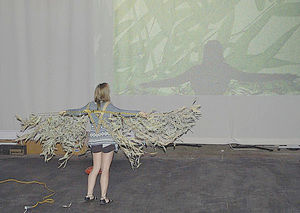The Hidden Garden
Published 8:27 am Tuesday, May 10, 2016

- The Hidden Garden
Bamboo Installation & Multi-Disciplinary Theatrical Event
br
Trending
By Shanna Perkins / Submitted Photos
Immense insect skeletal structures twitch to life before creeping and lurching across the dim stage. Projections light the back of the space as bamboo leaves come in and out of focus, changing angles and direction. Dancers bound onto stage with flexed feet and bent elbows, engaging in a quasi battle with other dancers garnishing the skeletal remains of insects. This is just glimpse behind the gate of “The Hidden Garden” Bamboo Installation – A Multi-Disciplinary Theatrical Event.
Trending
“The Hidden Garden” was created to be part of ArTech Fusion 2016 at the Acadiana Center for the Arts. ArTech endorses the dynamic and intertwined relationship between arts and technology. The program consists of performances, installations and presentations that reside in the crosshairs of art and technology.
Having participated in the 2015 event, University of Louisiana at Lafayette Associate Professor of Industrial Design Andy Loewy applied for a $1,000 grant, which his team was awarded, so that he could create a multifaceted work of art produced by a troop of professionals and students from varying backgrounds within the university – Faculty Design Advisors Andy Lowey and Thomas Cline; Lighting Designer Shannon R. Miller; Stage Manager Samantha Degeyter; Sound and Projection Designer Keith Dorwick; Theatrical Director Carl C. Granieri; Dance Director and Choreographer Kenneth Jenkins.
“The collaborative process is very exciting for me and it’s partially because you don’t know what the end result is going to be,” Loewy explains. “There is this magic that happens when you have energy coming from various people from different disciplines. The entire goal of collaboration is to hope that the whole is greater than its parts and I think we achieved that. I think it turned into a piece of art that was really exciting. We gave birth to something new and different.”
Another fundamental component of the production’s success was a free source of their material of choice – bamboo. Mike Richard, the owner of Jefferson Island, generously allowed the “Hidden Garden” team to visit the bamboo grove that is located on Jefferson Island and make use of what they pleased. Bamboo was a natural option for multiple reasons. Loewy explains that aside from being “a beautiful and sustainable material,” it’s a light and pliable material. Thomas Cline also had experience with bamboo from his time teaching in Thailand at Shanghai University.
“In addition to Andy and Thomas’ knowledge of the material, the other part of the history is that that ArTech Fusion always has a theme, and this year’s was earth,” explains Sound and Projection Designer Keith Dorwick. “It was very interesting for us to think about the concept of what earth means and how to represent it. So, we came up with dichotomies – inside and outside, light and dark, decaying and growing, human world and insect world.”
The student design team was composed of Devin Comeaux, Brian Nguyen, Alina Nguyen, Steven Nguyen, Curtis Vice, Katelyn Frame, Sam Riehl, Erika Avery, CeCe Ducote and Sam Bridgeman. Once the material was determined and the focus on the contrast of the human and insect world was established, the student designers could begin to toy with these notions. The students were divided into two groups. One group created complete bug structures and the other created pieces to be worn by hybrids – humans yielding and wearing bug parts. The remains of their work litter the Second Year Industrial Design Studio in Fletcher Hall. Large bamboo insect designs hang from the ceiling like vacated cicada skins. Wings and antennas are scattered across the table where a beetle with movable lower jaw mechanisms looms from the center of the pseudo insect graveyard.
“Andy and I were involved in making four bugs that were entirely mechanical,” states Student Designer Brian Nguyen while moving the jaw of the beetle he created. “They were very intuitive and fastidious in their design. Each of them functioned differently. My scorpion had pinchers and I designed a mechanism so that the claws could open and close with a lever and my beetle has a pivot for the jaw. The spider I designed so the legs would move in alteration.”
While the larger insects were being designed, the second group of designers was hard at work designing individual insect parts for the “hybrids” to wear. As Loewy explains this he slips on one of the hybrid attachments, a helmet covered in bamboo antennas. The different approaches can be seen in the details of each piece.
“There were different approaches from the start,” says Student Designer Erika Avery. “It was difficult finding out how this assembly line was going to work. Several of us were just learning to use the bamboo and how to make all of the curves and connections. Once we figured out our systems, we began focusing on creating the bug heads and the more prosthetic attachments for the dancers to wear.”
As the student designers ogled over insect parts and manipulated bamboo into antennas, wings and thoraxes, the building of the other layers of media began. For the visual, Dorwick created four 12-minute videos of bamboo and bamboo leaves. The projection style videos created a backdrop with transparency that generated an additional level of light and shadows. To assists with the music and production, Dorwick brought in Theatrical Director Carl C. Granieri. The pair gathered various quotes about gardening or insects from assorted pieces of literature and poetry.
The voice work was laid over the live music of violinist Michael Blaney and guitarist Jeffrey George. While playing “Dances in the Mad House,” Blaney and George served as an additional layer as they were visible beneath the projections. Choreographer Kenneth Jenkins was brought in to create accompanying movement and while he confesses that it was a new experience for him, it was also an invaluable one for himself and his dancers.
“I enjoyed watching the problem solving,” he expresses. “Especially watching the architecture students solve problems. Dancers usually have very type-A personalities; they strive for perfect 10s and anything less than that can be viewed as a failure. I want my dancers to see this problem solving and I want them to remain flexible in terms of their performance. They get so caught up in perfect and this wasn’t that kind of experience for them.”
Collaborating with different expertise across the university was an eye-opening experience for everyone involved. Loewy reflects Jenkins sentiment, stating that the flexibility required in the collaborative process was also beneficial to designers who were given the opportunity to break away from preconceived ideas about their work and learn new ways to approach it. Student Designer Sam Riehl explains that the process taught him that experimenting and playing with new mediums is all part of a larger learning experience. And for Nguyen, the project changed his path entirely.
“I was in Architecture when I started this project and we’re geared to more rigid materials like concrete, steel, iron,” he states. “It was refreshing to work with such a natural, biodegradable, pliable material that it inspired me to switch my major from Architecture to Industrial Design.”
As the group explains, they did receive comments that the project wasn’t tied up in a bow – that it had a few frays along the edges. But, that’s not what it’s about. It’s about bringing together artists from different fields to layer their expertise and knowledge while shattering the boxes they generally work within. And when something is shattered, it never has clean edges.
brbrbrbrbrbrbrbrbrbrbrbrbrbrbrbrbr
“I am technically an architect, but I tend to consider myself a designer” Cline reasons. “I think this research is pushing the boundaries of what we might call ‘design.’ This is design, but it’s also performing arts, dance, language, music. It’s comprehensive of what design could be. And it leads us to a new possibility of what we might think when we say ‘design.’”





